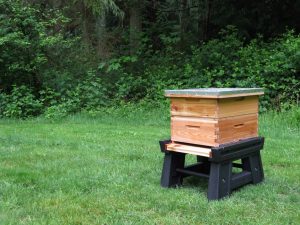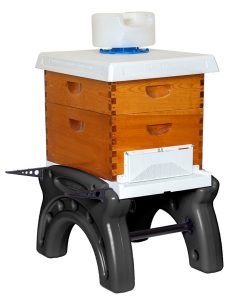While you could start a beehive by setting your hive directly on the ground and the bees might just make do, at least for a while, utilizing a hive stand for all your hives is nearly a prerequisite in beekeeping. Hive stands are available commercially, and can also be made as a do-it-yourself home project. A hive stand will serve many purposes – so many in fact, that almost all beekeepers use one of some sort.

The first purpose a hive stand will serve is to protect the bees from predators. Luckily, honey bees can in many cases protect themselves, but a hive stand will only help them along. Predators both large and small will take interest in a beehive – from the honey within to the bees themselves. Ants are one concern that can affect a colony of honey bees, especially one that’s already weak for other reasons. Having your hives elevated will make things harder for ants, and can also allow a beekeeper to isolate the hive by setting the hive stand’s legs in ant guards all around – a moat-like trap filled with a liquid that ants can’t crawl through.
Skunks are larger predators that love to eat the bees themselves. By raising the hive up off the ground a skunk either cannot reach the entrance of the hive or has to stand up to reach the entrance – thereby exposing their underbelly to stings. While falling in-between in size, if mice can get in your hives during the winter they will. By raising your hives we are not completely defending the hive from smaller critters such as mice (an entrance reducer and mouse-guard are still needed!), but we’re not making it any easier, either. In some areas, bears are another concern. However, your hive stand – unfortunately – will not offer any protection in this regard. Look to an electrified fence if this is a concern in your area.
Another threat to bees is snow, and moisture. Elevating your hives helps with both and allows for decent snows without encasing the hive in snow drifts. Additionally, spring-time rains or snowmelt can temporarily waterlog the typically dry ground around your apiary. Getting your hives up and above all this moisture allows the bees to control their own environment. And keep in mind that in nature, bees choose tree hollows that are elevated, for all of these same reasons.

Lastly, another benefit of a hive stand is that it’s easier for the beekeeper! Beekeeping can already be quite the workout and by raising your hives up off the ground things will be much easier on a beekeeper’s back when stooping to pull out frames or lift those heavy boxes.
Hive stands like the Ultimate Hive Stand and our Cedar Hive Stand can be purchased off the shelf and are ready to go as an easy way to elevate your hives. Additionally, many beekeepers have utilized everything from cinder blocks to water heater stands to home-built wooden stands and more. In commercial beekeeping, pallets are ubiquitous.
No matter what type of hive stand you choose and however which way you choose to go about it, raising your hives up off the ground only helps to help the bees in nearly every regard, and helps to make beekeeping more enjoyable for every beekeeper.

